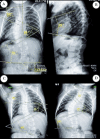The use of magnetically controlled growing rod device for pediatric scoliosis
- PMID: 26818162
- PMCID: PMC5224406
- DOI: 10.17712/nsj.2016.1.20150266
The use of magnetically controlled growing rod device for pediatric scoliosis
Abstract
Objective: To study the safety and efficacy of an innovative device using distraction-based magnetically controlled growing rods (MCGR) for the treatment of pediatric scoliosis.
Methods: This is an evidence-based systematic review of literature for the surgical management of patients with pediatric scoliosis using MCGR technique. Six clinical studies regarding the use of MCGR were included in this review, with a total of 68 patients, and mean age of 8.38 years. The dual-rod (DR) technique of rod construct with MCGR was used in 33.85% and the single-rod (SR) in 66.15% of the patients.
Results: The mean preoperative main coronal curve for the DR was 65.9°, and for the SR was 69.6° (p>0.05). At the latest follow-up, it was 36.8° for DR and 43.0 degrees for SR (p<0.05). The mean preoperative T1 - S1 spinal length was 298.7 mm for the DR and 303.5 mm for the SR group (p<0.05). According to the latest follow-up, using the DR construct, the spinal length increased to 347 mm with 13.92% of total lengthening; and using the SR construct, the average lengthening was 339 mm, with 10.48% of total lengthening (p<0.05). Postoperative complications were similar, 25% in DR and 31.57% in the SR group (p>0.05).
Conclusion: Level IV of medical evidence supports the use of MCGR as a safe and effective alternative for the treatment of severe pediatric scoliosis. Recommendation Grade C supports the role of MCGR with DR construct as an option to achieve a better correction of the scoliotic curve and to maximize the postoperative T1 - S1 spinal length.
Figures




References
-
- James JIP. Idiopathic scoliosis:The prognosis, diagnosis, and operative indications related to curve patterns and the age at onset. J Bone Joint Surg Br. 1954;36:36–49. - PubMed
-
- Lenke LG, Dobbs MB. Management of juvenile idiopathic scoliosis. J Bone Joint Surg Am. 2007;89:55–63. - PubMed
-
- Dickson RA. Early-Onset Idiopathic Scoliosis. In: Weinstein S, editor. The Pediatric Spine: Principles and Practice. New York (NY): Raven Press; 1994. pp. 421–429.
-
- Dangerfield PH. The classification of spinal deformities. Pediatr Rehabil. 2003;6:133–136. - PubMed
Publication types
MeSH terms
LinkOut - more resources
Full Text Sources
Other Literature Sources
Medical
Research Materials
